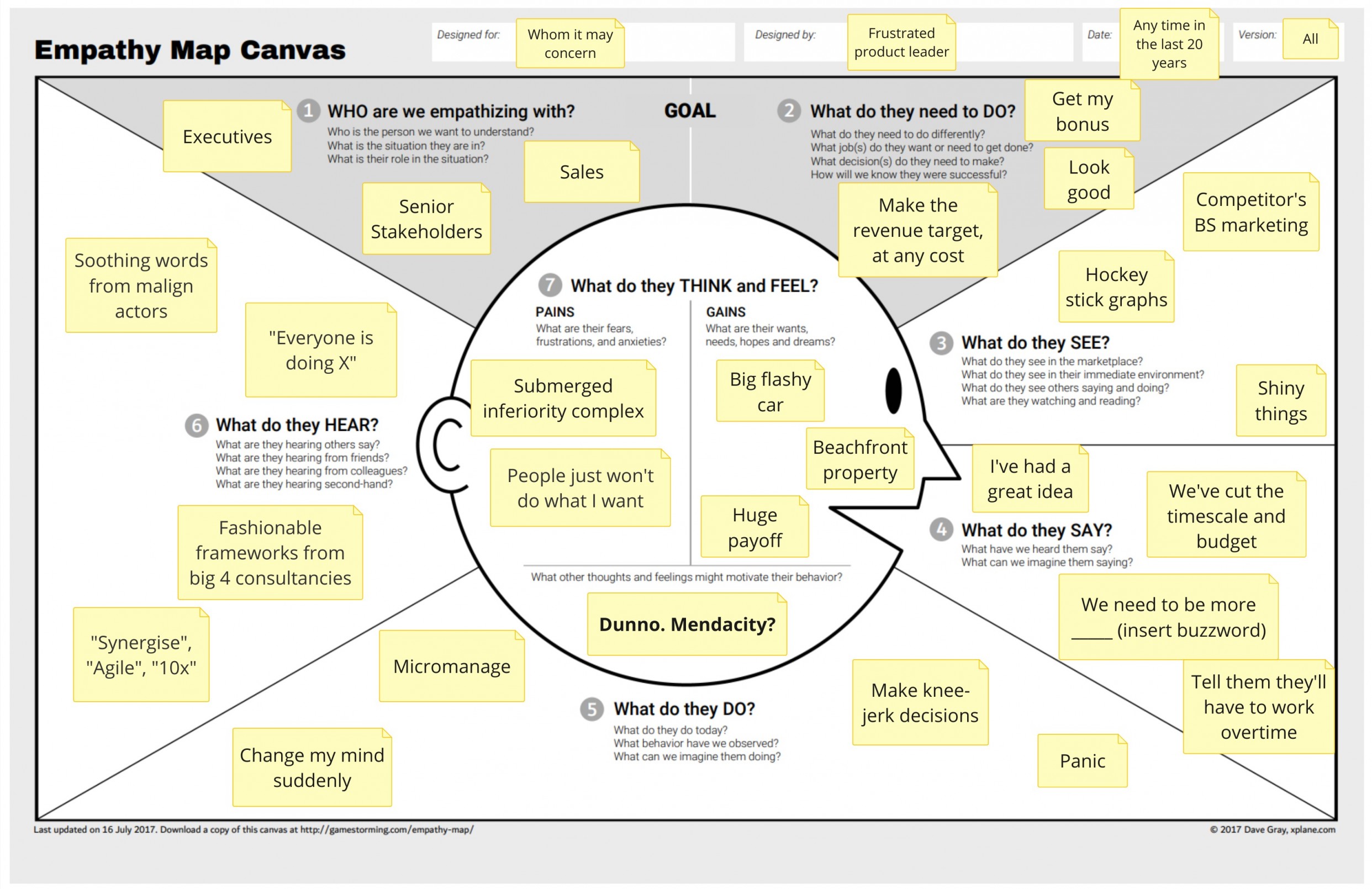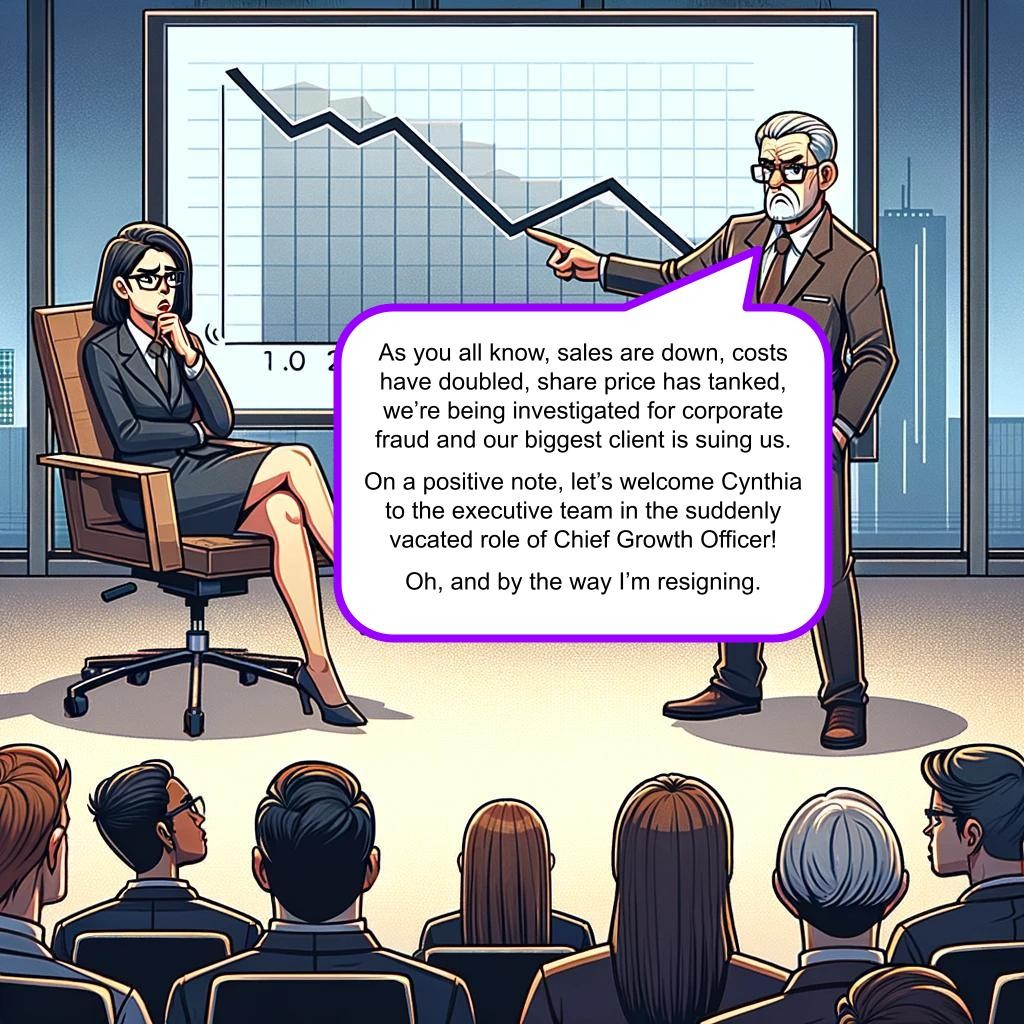
I’ve been reading blogs, tweets, white papers and newsletters about product management for many years. I’ve worked with hundreds of companies and thousands of product managers. They’re generally an expressive lot, with broad skills and a positive mindset. Despite this, they do seem to spend a lot of time complaining.
The principal targets of their dissatisfaction are senior stakeholders, code for “bosses”. Senior stakeholders (I’ll use “CxOs” as shorthand for these, “SS” being inappropriate if somewhat accurate) give vague strategic direction, issue orders, micromanage, change direction without warning or explanation, are ignorant of what’s really happening in the business and think only of their remuneration. Why do we need these stuffed suits?
In response to this, the concept of stakeholder management promises to empower mid-tier professionals to manage up so that those child-like CxOs can be kept in their box, safely out of the way of the real work. Clever wheezes have been developed such as issuing ‘override passes’ to CxOs, which serve both to limit the frequency with which they (apparently arbitrarily) dictate specific activities without regard to agreed strategy, and to highlight to said CxOs just how often they actually try to do this.
Less passive-aggressive approaches involve trying to second-guess the character types of CxOs and then tailoring one’s communications with them accordingly. The Stakeholder Salience Model, Power-Interest Grid and Engagement Planning are all useful situational tools that can help to visualise existing relationships and to plan how you’re going to influence - or defend against - them.
However I feel that they all exhibit a certain condescendence, reducing colleagues to mere cyphers: bubbles on a chart coloured red, green, blue or yellow to indicate one’s disposition towards them. It’s reminiscent of how customer personas are all-too-often created - by a small group of people pulling prejudices from their nether regions to create monstrous stereotypical chimeras that utterly fail to explain why people behave the way they do.
Why does the product world so ardently evangelise customer research only for external customers? If they did, perhaps they’d find that CxOs aren’t necessarily malevolent, myopic dimwits that care only about climbing the greasy pole. They might discover that there are things that happen in boardrooms that simply can’t be discussed outside for commercial, legal and ethical reasons. “Radical Transparency” you may shout, but in my experience many people want to know what’s happening at the pointy end of a business only until they do, then they often wish they didn’t. It’s just not for everyone.

The flipside of this schism is that executives often become detached from the actual day-to-day business, where value is created and money is made. The endless conveyor belt of existential threats conditions them into what I might call a state of crisis paralysis, in which they resemble company-level firefighters, permanently reacting to events instead of creating an environment for success; There’s too much “important and urgent” and not enough “important but not urgent”.
Another challenge for executives is that mostly they have ascended to their current position through a silo. Marketing Assistant, Marketing Specialist, Marketing Manager, VP of Marketing, CMO. Along the way they work alongside - and sometimes against - other silos, but never really get them, and now they find themselves in the same team as a CHIEF TECHNOLOGY OFFICER. Sadly, being promoted to a senior management position doesn’t magically open one’s mind to radically different perspectives. It brings a requirement that the team make a show of unity, belying the bloody savagery that can take place behind the boardroom door.
OK, so maybe things aren’t like that in your business. However, executive teams do have a particular problem with being misunderstood by the rest of the people in their business, in that most or all of them have never been an exec and lack insight into how the job works. How should we address this?
I believe that a company that claims to be a product business (never mind “product-led”, whatever that means) should apply product thinking to everything it does. This means always striving to create solutions to customer problems and helping them to exploit opportunities, in a sustainably profitable way. Expanding the definition of “customer” to include internal stakeholders, then why wouldn’t we apply the same approach?
To do this, you need to:
- Conduct research to find out what’s actually happening in your market, as opposed to following opinions and preconceptions;
- Know who your customers are - what motivates them, what they need, the problems they encounter;
- Balance company capabilities and resources so as to achieve maximum customer benefit and profit for the company;
- Work in accordance with a set of choices (i.e. a strategy) previously agreed within the company, and framed appropriately for each scope of activity;
- Continuously check, validate and, if necessary, adjust your activities (and, if necessary, strategy) to ensure that you’re still doing in the right direction.
If you substitute the word “customer” for “stakeholder” in this list, then this can provide useful guidance on stakeholder management:
- When creating a business case, think of it as a value proposition to your business, which requires you to understand your target customers (those CxOs) really well, which in turn means conducting research with them.
- Reporting to CxOs becomes like customer retention or account management, in that you need to communicate how great your product is, enthuse them with your roadmap and convince them to keep ‘buying’.
- When a CxO comes to you with an idea, you need to treat it as you would a feature request from a customer: resist answering with “yes” or “no” and instead welcome it as valuable customer feedback. If a CxO tries to tell you to execute a solution, enthusiastically enquire as to the problem that they’re trying to solve.
Overall, remember that senior stakeholders are people too, and if you don’t understand their behaviour and motivations well enough to create great solutions for them, then you have your work cut out.
Share
Keep reading ...
Blog 3 min read
January 25th, 2020 - by Olivia Stiles
